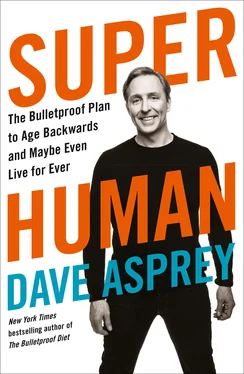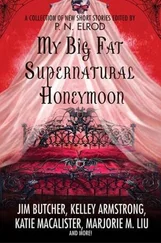My premature aging makes complete sense to me now. Mitochondria, which are bacteria embedded in most of our cells, power our energy production. Back when we were single-celled creatures, we became host cells for ingested bacteria. Over millions of years of evolution, the host cell became humans, the ingested bacteria became mitochondria, and today neither of us can survive without the other. Mitochondria are not of human origin; they even have their own DNA. And what has posed a lethal threat to bacteria since the beginning of time? Mold.
This means the very powerhouses of my cells were constantly engaged in a battle with their mortal enemy, and this fight left behind many casualties. When cells are under chronic stress, their mitochondria cannot make energy efficiently. This leads to an increase in the production of molecules called reactive oxygen species (ROSs), also known as free radicals. ROSs are unstable molecules that contain atoms with unpaired electrons, making them highly reactive. When an excess of free radicals are present in cells, they cause a chemical reaction that damages your cellular structures in a process called oxidation.
This is exactly what happens as you age, whether or not toxic mold is present in your life: Mitochondria function steadily declines, leading to an increase in free radicals, which damage your cells. In response, your body sends vitamin C from food to the liver so it can produce antioxidants, which fight off free radicals. The problem with this process is that it leaves you without enough vitamin C to produce collagen, the protein in the connective tissue of your skin, teeth, bones, organs, and cartilage. Vitamin C interacts with amino acids to build collagen, but only if you have enough of it. Your body will gladly sacrifice healthy blood vessels and skin in favor of fighting off free radicals that are draining its energy source.
This is precisely why I had stretch marks and vascular issues (manifested as nosebleeds) and why most people don’t develop these symptoms until they’re much older. The fight in my body between my onboard bacteria and mold left me constantly depleted of antioxidants. And my mold-damaged mitochondria also laid the groundwork for prediabetes, poor blood flow to the brain, arthritis, cognitive dysfunction, and, according to one doctor, a high risk of stroke and heart attack. I was still in my twenties, but I was biologically old because my mitochondria were slowing down. And it really pissed me off.
MITOCHONDRIA AND THE FOUR KILLERS
As I fought my way back from experiencing the many symptoms of aging, my likelihood of dying from the Four Killers dropped dramatically. That’s because—surprise, surprise—they all have one underlying issue in common: the cumulative damage to your cells, and in particular, to your mitochondria, that takes place over the course of a lifetime. This damage occurs in all of us, though at varying rates. Some damage stems from the bad choices we make, but much of it is simply the price we pay for the basic functions that support life—like metabolizing food and breathing.
You die a little bit every day from these cuts that make you weaker in the short term and hasten your decline in the long term. Staying alive requires avoiding as many of those cuts as possible, but they are all around you—in your food, your air, your light sources, and throughout your environment. You may not associate these cuts with your likelihood of aging prematurely or of developing a degenerative disease, but like every other aspect of your biology, they are all connected. The cuts lead to aging, aging leads to disease, and disease leads to death.
If you’re in your twenties or thirties, you may think you’re in the clear—that these cumulative cuts aren’t affecting you yet. But the cuts from bad choices or a toxic environment begin to add up from an early age—and they’re hurting you even if you’re not currently feeling their effects (such as weight gain, brain fog, muffin top, and fatigue). And it’s a lot easier to avoid damage to your mitochondria than it is to reverse it later.
Your mitochondria are responsible for extracting energy from the food you eat, and then combining it with oxygen to produce a chemical called adenosine triphosphate (ATP), which stores the energy your cells need to function. When your mitochondria conduct this process efficiently, they produce lots of energy so you can perform at your greatest potential—like a young person. But if your mitochondria become damaged or dysfunctional as you age, they begin producing an excess of free radicals in the process, which leak into the surrounding cells and lay the groundwork for the Four Killers. Congratulations, you are now old.
Even young, efficient mitochondria produce some free radicals as by-products of creating ATP, but they also make antioxidants, compounds that inhibit the damaging effects of free radicals. This is why products containing antioxidants have “anti-aging” properties. While popping antioxidant supplements and using skin-care products containing antioxidant-rich ingredients are worthwhile interventions, they are, frankly, the low-hanging fruit of our Super Human tree. For you to truly remain young, those antioxidants have to be produced by your body—your mitochondria must create at least as many of them as it does free radicals. When your mitochondria become inefficient, they make an excess of free radicals and fewer antioxidants. And you can’t slather enough serums onto your skin to fully counteract the damage created by this imbalance.
Your mitochondria are also in charge of triggering cellular apoptosis, programmed cell death that occurs when a cell is old and/or dysfunctional. If your mitochondria are sluggish, they may not trigger apoptosis at the right times, which can result in healthy cells dying off before they should or dysfunctional cells sticking around past their prime and aging you before your time.
When you’re still young and exploding with mitochondrial energy, you can take some of these hits. You can eat garbage, drink too much cheap beer, forgo sleep, and still function pretty well because you’re producing lots of antioxidants and energy. As you get older, you start to see that you can’t stay out all night drinking and still really bring it at work the next day. By the time you wake up to this new reality, you’ve already taken a lot of hits that will age you in the long run. But you’re likely to keep running at the edge of what you can perceive, so the damage stacks up without you even knowing it.
Well, what if you made better choices throughout your life so you took fewer hits over the course of decades? Then when you got to the age of seventy you might look and feel more like fifty because you simply suffered less damage. You’re never going to be able to avoid all the cuts—again, simply breathing creates some amount of wear and tear over time. It’s a matter of preventing as much damage as possible, which happens to dovetail nicely with the first rule of biohacking: Remove the things that make you weak. This is in and of itself a powerful anti-aging strategy.
When your mitochondria start to slow down and create an excess of free radicals, the result is widespread chronic inflammation throughout your body. Inflammation is such a hot topic in the field of longevity that you probably already know how closely it’s linked to aging. When I was sick and old as a young man, I knew I was inflamed, but I had no clue this stemmed from mitochondrial dysfunction, nor did I know that inflammation was more than a painful annoyance. I had no idea that inflammation creates the ideal circumstances for each of the Four Killers to thrive.
HEART DISEASE
A condition known as atherosclerosis, hardening of the arteries, is the first obvious clinical sign that heart disease has started. But what causes this? A thin layer of cells called the endothelium lines your arteries. When the endothelium is damaged, fats can cross into the arterial wall and form plaques. This is bad enough, but when your immune system picks up on the fact that this is happening, it creates chemical messengers called inflammatory cytokines to attract white blood cells to those plaques. This is an inflammatory immune response. When those plaques rupture because they are so inflamed, blood clots form, and these clots are the real cause of most heart attacks and strokes.
Читать дальше






